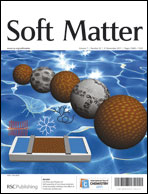Pickering emulsions stabilized by stacked catanionic micro-crystals controlled by charge regulation†
Abstract
In this paper the mechanism behind the stabilization of Pickering emulsions by stacked catanionic micro-crystals is described. A temperature-quench of mixtures of oppositely charged


 Please wait while we load your content...
Please wait while we load your content...